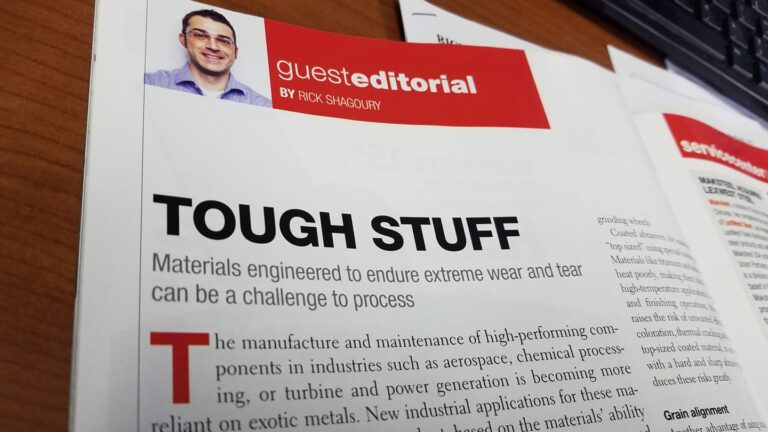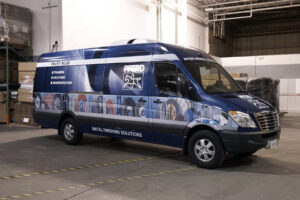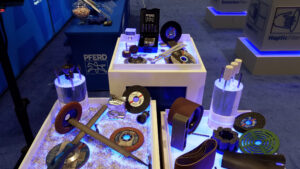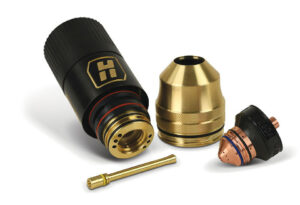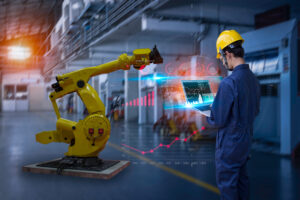In 2019, while working with PFERD INC., I had the opportunity to submit an editorial to a trade publication with whom we worked frequently.
As Marketing Communications Manager, editing and coordinating these types of pieces with the trade pubs was really nothing new.
However, in this particular case, the piece was a “guest editorial”, making me the featured contributor and subject matter expert. It felt like the culmination of my many years with the company, to be able to convey, in a nuanced and effective way, the benefits of our products to a very niche market, in this case, machining of extremely tough exotic metals.On top of all that, the finished piece was published with almost no edits to my original submitted draft!
Here’s “Tough Stuff“, From the May 2019 issue of Modern Metals
Materials engineered to endure extreme wear and tear can be a challenge to process
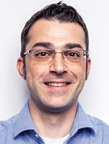 May 2019 – The manufacture and maintenance of high-performing components in industries such as aerospace, chemical processing, or turbine and power generation is becoming more reliant on exotic metals. New industrial applications for these materials have become more prevalent, based on the materials’ ability to withstand extreme temperatures, sustain high wear and stress, and resist chemically corrosive environments.
May 2019 – The manufacture and maintenance of high-performing components in industries such as aerospace, chemical processing, or turbine and power generation is becoming more reliant on exotic metals. New industrial applications for these materials have become more prevalent, based on the materials’ ability to withstand extreme temperatures, sustain high wear and stress, and resist chemically corrosive environments.
When manufacturing high-performance components for automobile, aerospace and military applications, for example, engineers seek to specify materials that are durable in high-wear situations and will not deform, weaken or wear when used in high-powered engines or other machinery.
Exotic metals such as titanium or zirconium offer extremely high-tensile strength and high temperature resistance. This helps keep components within tolerances during operation, as they feature a low coefficient of expansion and will not alter in geometry significantly when exposed to extreme temperatures.
However, the properties that make these metals so ideal for high-stress use also create some challenges when machining, grinding or finishing them. And, as they tend to be very expensive, a proper approach to processing these materials is essential to productivity and cost-effectiveness. As in any operation, mistakes and rework can result in unexpected investments of time and money.
High durability due to extreme hardness and tensile strength leads to obvious difficulties. For optimal results when machining with abrasive products, manufacturers are encouraged to carefully select the grain type. Common “impact grains,” such as aluminum oxide or zirconia alumina, will perform poorly on titanium, causing glazing of the abrasive product. This is due to the abrasive grain being dulled by repeated contact with the extremely hard workpiece, eventually rendering it useless and wasting time and money.
Hard and sharp
When grinding exotic materials and alloys, the use of extremely hard and sharp abrasive grains is best. Diamond and cubic boron nitride (CBN) grains are commonly used for grinding titanium. However, depending on the nature of the work, it is also possible to get good results with more cost-effective abrasive grains, such as silicon carbide (SiC) and ceramic oxide (CO), both of which are ideal for fast, cool and precise grinding.
Although the choice of abrasive grain is key, equally important is the format and construction of the consumable product that introduces the grain to the metal. In many cases, products featuring coated materials, such as belts, flap discs and fan grinders, have advantages over bonded abrasives like mounted points and resin grinding wheels.
Coated abrasives, for example, can be “top sized” using special cooling additives. Materials like titanium and nickel conduct heat poorly, making them ideal for use in high-temperature applications. In grinding and finishing operations, this property raises the risk of unwanted effects like discoloration, thermal cracking and fatigue. A top-sized coated material, in conjunction with a hard and sharp abrasive grain, reduces these risks greatly.
Grain alignment
Another advantage of using coated abrasives on exotic metals is the optimized alignment of the grain. In coated materials, the abrasive grain is positioned on the surface of the material using a field of static electricity. This ensures that the sharp tips of the individual grains are aligned for maximum, consistent contact with the workpiece. When used at proper speed and pressure, this will help reduce glazing and loading of the abrasive material, while maximizing removal rates.
Quality and durability are top priorities for every single aerospace or defense component. The precision and uniformity of all processing steps is as crucial as careful control during machining processes for the special materials being used to manufacturing those components.
Manufacturers should learn the specific wear and performance characteristics of the materials they are using in order to achieve the best results on finished parts. As exotic metals continue to be used in these industries for high-stress applications, the goal is to get the job done right the first time. Avoiding rework and maximizing the work done by abrasive products will optimize productivity when working with these expensive and critical components. MM
Rick Shagoury is marketing communications manager of Pferd Inc., the U.S. subsidiary of abrasives manufacturer August Rüggeberg GmbH & Co., Marienheide, Germany. 800/342-9015

